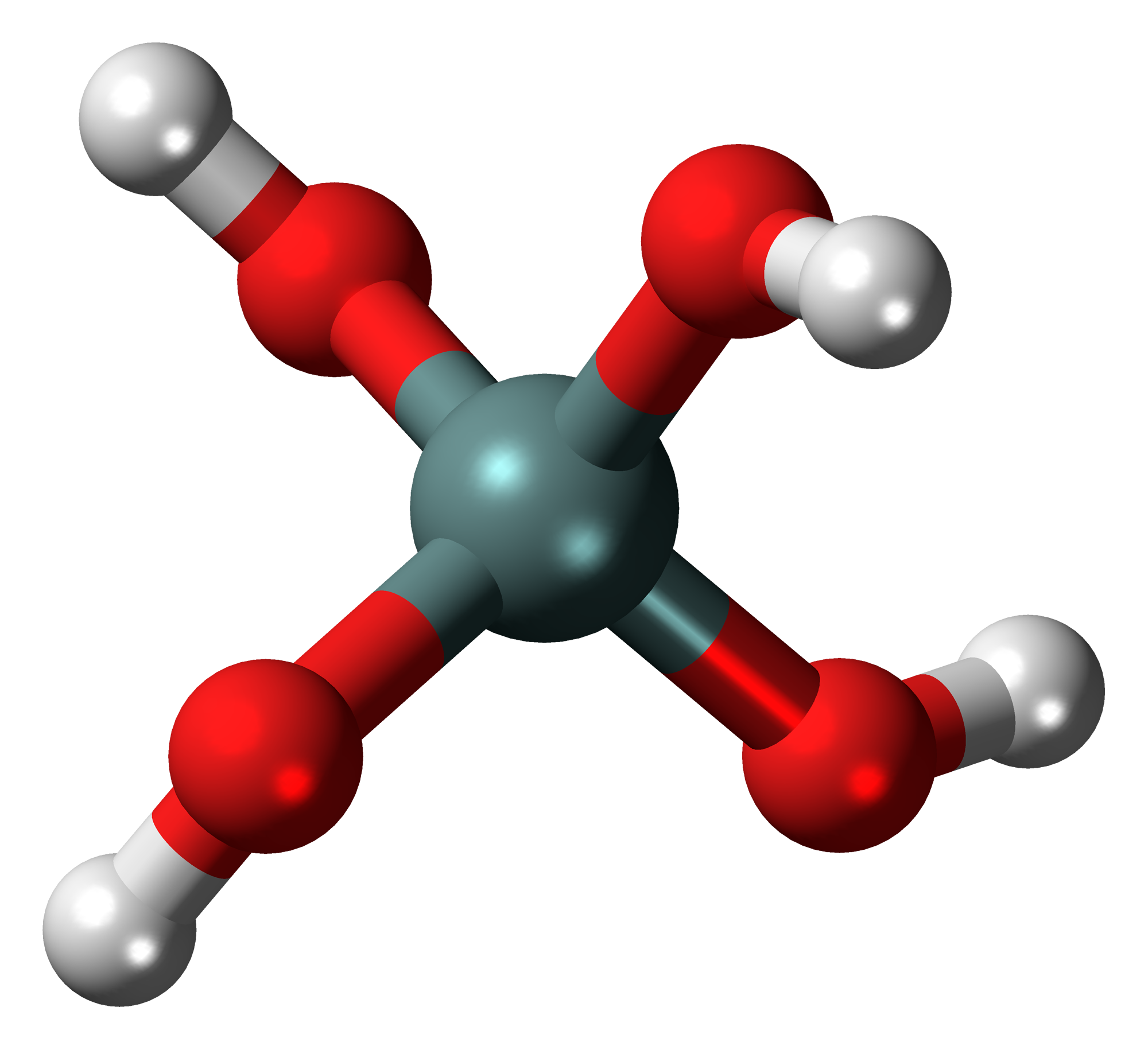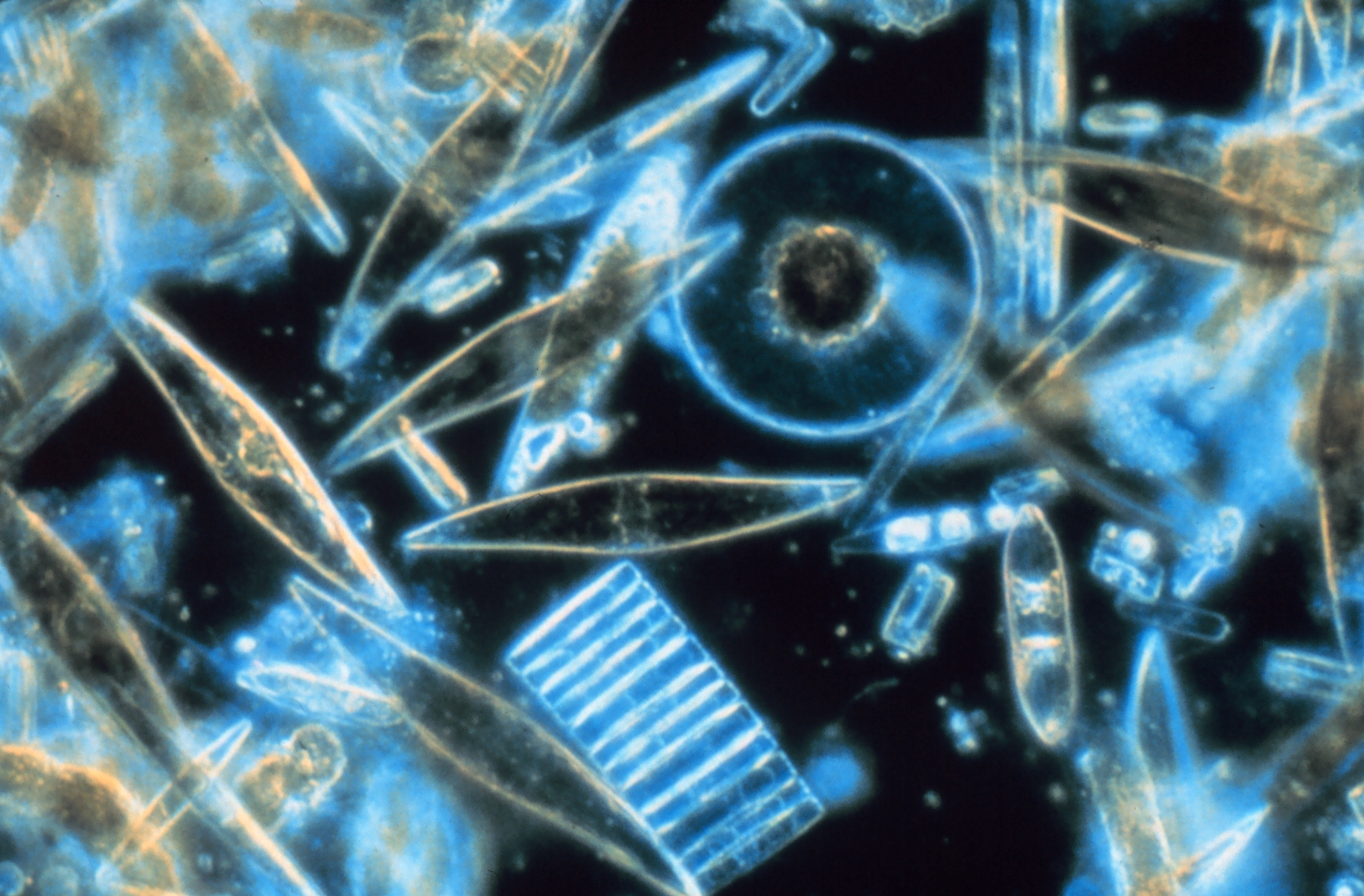|
Diatom Frustule
A frustule is the hard and porous cell wall or external layer of diatoms. The frustule is composed almost purely of silica, made from silicic acid, and is coated with a layer of organic substance, which was referred to in the early literature on diatoms as pectin, a fiber most commonly found in cell walls of plants. This layer is actually composed of several types of polysaccharides.Progress in Phycological Research: v. 7 (1991) by F.E. Round (Volume editor), David J. Chapman (Volume editor) The frustule's structure is usually composed of two overlapping sections known as thecae (or less formally as valves). The joint between the two thecae is supported by bands of silica (girdle bands) that hold them together. This overlapping allows for some internal expansion room and is essential during the reproduction process. The frustule also contains many pores called areolae and slits that provide the diatom access to the external environment for processes such as waste removal and muci ... [...More Info...] [...Related Items...] OR: [Wikipedia] [Google] [Baidu] |
Diatoms
A diatom (Neo-Latin ''diatoma'') is any member of a large group comprising several Genus, genera of algae, specifically microalgae, found in the oceans, waterways and soils of the world. Living diatoms make up a significant portion of Earth's Biomass (ecology), biomass. They generate about 20 to 50 percent of the oxygen produced on the planet each year, take in over 6.7 billion tonnes of silicon each year from the waters in which they live, and constitute nearly half of the organic material found in the oceans. The Protist shell, shells of dead diatoms are a significant component of marine sediment, and the entire Amazon basin is fertilized annually by 27 million tons of diatom shell dust transported by transatlantic winds from the African Sahara, much of it from the Bodélé Depression, which was once made up of a system of fresh-water lakes. Diatoms are unicellular organisms: they occur either as solitary cells or in Colony (biology), colonies, which can take the shape of ribb ... [...More Info...] [...Related Items...] OR: [Wikipedia] [Google] [Baidu] |
Silica
Silicon dioxide, also known as silica, is an oxide of silicon with the chemical formula , commonly found in nature as quartz. In many parts of the world, silica is the major constituent of sand. Silica is one of the most complex and abundant families of materials, existing as a compound of several minerals and as a synthetic product. Examples include fused quartz, fumed silica, opal, and aerogels. It is used in structural materials, microelectronics, and as components in the food and pharmaceutical industries. All forms are white or colorless, although impure samples can be colored. Silicon dioxide is a common fundamental constituent of glass. Structure In the majority of silicon dioxides, the silicon atom shows Tetrahedral molecular geometry, tetrahedral coordination, with four oxygen atoms surrounding a central Si atomsee 3-D Unit Cell. Thus, SiO2 forms 3-dimensional network solids in which each silicon atom is covalently bonded in a tetrahedral manner to 4 oxygen atoms. ... [...More Info...] [...Related Items...] OR: [Wikipedia] [Google] [Baidu] |
Silicic Acid
In chemistry, a silicic acid () is any chemical compound containing the element silicon attached to oxide () and hydroxyl () groups, with the general formula or, equivalently, . Orthosilicic acid is a representative example. Silicic acids are rarely observed in isolation, but are thought to exist in aqueous solutions, including seawater, and play a role in biomineralization. They are typically colorless weak acids that are sparingly soluble in water. Like the silicate anions, which are their better known conjugate bases, silicic acids are proposed to be oligomeric or polymeric. No Monomer, simple silicic acid has ever been identified, since these species are primarily of theoretical interest. Depending on the number of silicon atoms present, there are mono- and polysilicic (di-, tri-, tetrasilicic, etc.) acids. Well defined silicic acids have not been obtained in a form that has been characterized by X-ray crystallography. Examples Reactions Silicic acids can be seen as hy ... [...More Info...] [...Related Items...] OR: [Wikipedia] [Google] [Baidu] |
Pectin
Pectin ( ': "congealed" and "curdled") is a heteropolysaccharide, a structural polymer contained in the primary lamella, in the middle lamella, and in the cell walls of terrestrial plants. The principal chemical component of pectin is galacturonic acid (a sugar acid derived from galactose) which was isolated and described by Henri Braconnot in 1825. Commercially produced pectin is a white-to-light-brown powder, produced from citrus fruits for use as an edible gelling agent, especially in jams and jellies, dessert fillings, medications, and sweets; as a food stabiliser in fruit juices and milk drinks, and as a source of dietary fiber. Biology Pectin is composed of complex polysaccharides that are present in the primary cell walls of a plant, and are abundant in the green parts of terrestrial plants. Pectin is the principal component of the middle lamella, where it binds cells. Pectin is deposited by exocytosis into the cell wall via vesicles produced in the Golgi appara ... [...More Info...] [...Related Items...] OR: [Wikipedia] [Google] [Baidu] |
Plant
Plants are the eukaryotes that form the Kingdom (biology), kingdom Plantae; they are predominantly Photosynthesis, photosynthetic. This means that they obtain their energy from sunlight, using chloroplasts derived from endosymbiosis with cyanobacteria to produce sugars from carbon dioxide and water, using the green pigment chlorophyll. Exceptions are parasitic plants that have lost the genes for chlorophyll and photosynthesis, and obtain their energy from other plants or fungi. Most plants are multicellular organism, multicellular, except for some green algae. Historically, as in Aristotle's biology, the plant kingdom encompassed all living things that were not animals, and included algae and fungi. Definitions have narrowed since then; current definitions exclude fungi and some of the algae. By the definition used in this article, plants form the clade Viridiplantae (green plants), which consists of the green algae and the embryophytes or land plants (hornworts, liverworts ... [...More Info...] [...Related Items...] OR: [Wikipedia] [Google] [Baidu] |
Polysaccharide
Polysaccharides (), or polycarbohydrates, are the most abundant carbohydrates found in food. They are long-chain polymeric carbohydrates composed of monosaccharide units bound together by glycosidic linkages. This carbohydrate can react with water (hydrolysis) using amylase enzymes as catalyst, which produces constituent sugars (monosaccharides or oligosaccharides). They range in structure from linear to highly branched. Examples include storage polysaccharides such as starch, glycogen and galactogen and structural polysaccharides such as hemicellulose and chitin. Polysaccharides are often quite heterogeneous, containing slight modifications of the repeating unit. Depending on the structure, these macromolecules can have distinct properties from their monosaccharide building blocks. They may be amorphous or even insoluble in water. When all the monosaccharides in a polysaccharide are the same type, the polysaccharide is called a homopolysaccharide or homoglycan, but when more t ... [...More Info...] [...Related Items...] OR: [Wikipedia] [Google] [Baidu] |
Theca
In biology, a theca (: thecae) is a sheath or a covering. Botany In botany, the theca is related to plant's flower anatomy. The theca of an angiosperm consists of a pair of microsporangia that are adjacent to each other and share a common area of dehiscence called the stomium. Larry Hufford, "The origin and early evolution of angiosperm stamens" i''The Anther: form, function, and phylogeny'' William G. D'Arcy and Richard C. Keating (editors), Cambridge University Press, 1996, 351pp, p.60, (from Google Books) Any part of a microsporophyll that bears microsporangia is called an anther. Most anthers are formed on the apex of a filament. An anther and its filament together form a typical (or filantherous) stamen, part of the male floral organ. The typical anther is bilocular, i.e. it consists of two thecae. Each theca contains two microsporangia, also known as pollen sacs. The microsporangia produce the microspores, which for seed plants are known as pollen grains. If the ... [...More Info...] [...Related Items...] OR: [Wikipedia] [Google] [Baidu] |
Mucilage
Mucilage is a thick gluey substance produced by nearly all plants and some microorganisms. These microorganisms include protists which use it for their locomotion, with the direction of their movement always opposite to that of the secretion of mucilage. It is a polar glycoprotein and an exopolysaccharide. Mucilage in plants plays a role in the storage of water and food, seed germination, and thickening membranes. Cacti (and other succulents) and flax seeds are especially rich sources of mucilage. Occurrence Exopolysaccharides are the most stabilising factor for microaggregates and are widely distributed in soils. Therefore, exopolysaccharide-producing "soil algae" play a vital role in the ecology of the world's soils. The substance covers the outside of, for example, unicellular or filamentous green algae and cyanobacteria. Amongst the green algae especially, the group Volvocales are known to produce exopolysaccharides at a certain point in their life cycle. It occu ... [...More Info...] [...Related Items...] OR: [Wikipedia] [Google] [Baidu] |
Aulacoseiraceae
Aulacoseirales is an order of diatoms belonging to the class Bacillariophyceae. The order consists only one family: Aulacoseiraceae. Genera Genera: * '' Alveolophora'' A.I.Moisseeva & T.L.Nevretdinova, 1990 * ''Aulacoseira ''Aulacoseira'' is a genus of diatoms belonging to the family Aulacoseiraceae. The genus has cosmopolitan distribution In biogeography, a cosmopolitan distribution is the range of a taxon that extends across most or all of the surface of ...'' G.H.K.Thwaites, 1848 * †'' Eoseira'' A.P.Wolfe & M.B.Edlund, 2005 * '' Pseudoaulacosira'' G.Lupikina & G.K.Khursevich, 1991 * '' Strangulonema'' R.K.Greville, 1865 References Bacillariophyceae Diatom families {{diatom-stub ... [...More Info...] [...Related Items...] OR: [Wikipedia] [Google] [Baidu] |
Diatomite
Diatomaceous earth ( ), also known as diatomite ( ), celite, or kieselguhr, is a naturally occurring, soft, siliceous sedimentary rock that can be crumbled into a fine white to off-white powder. It has a particle size ranging from more than 3 mm to less than 1 μm, but typically 10 to 200 μm. Depending on the granularity, this powder can have an abrasive feel, similar to pumice powder, and has a low density as a result of its high porosity. The typical chemical composition of oven-dried diatomaceous earth is 80–90% silica, with 2–4% alumina (attributed mostly to clay minerals), and 0.5–2% iron oxide. Diatomaceous earth consists of the fossilized remains of diatoms, a type of hard-shelled microalgae, that have accumulated over millions of years. It is used as a filtration aid, mild abrasive in products including metal polishes and toothpaste, mechanical insecticide, absorbent for liquids, matting agent for coatings, reinforcing filler in plastics and r ... [...More Info...] [...Related Items...] OR: [Wikipedia] [Google] [Baidu] |
Diatomaceous Earth
Diatomaceous earth ( ), also known as diatomite ( ), celite, or kieselguhr, is a naturally occurring, soft, siliceous rock, siliceous sedimentary rock that can be crumbled into a fine white to off-white powder. It has a particle size ranging from more than 3 millimeter, mm to less than 1 micrometre, μm, but typically 10 to 200 μm. Depending on the granularity, this powder can have an abrasive feel, similar to pumice powder, and has a low density as a result of its high porosity. The typical chemical composition of oven-dried diatomaceous earth is 80–90% silica, with 2–4% aluminum oxide, alumina (attributed mostly to clay minerals), and 0.5–2% iron oxide. Diatomaceous earth consists of the fossilized remains of diatoms, a type of hard-shelled microalgae, that have accumulated over millions of years. It is used as a filtration aid, mild abrasive in products including metal polishes and toothpaste, mechanical insecticide, absorption (chemistry), absorbent for ... [...More Info...] [...Related Items...] OR: [Wikipedia] [Google] [Baidu] |







